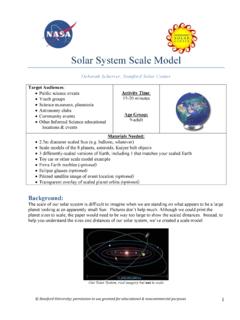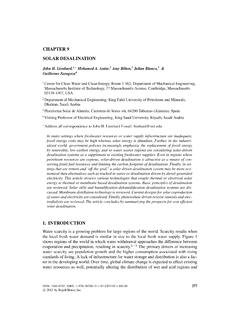Transcription of Scale Model of the Solar System - University of New Mexico
1 Scale Model of the Solar System Grade: 6-12. Subject: Space science and measurement conversion Purpose: Scientists us astronomical units (AU) when measuring distances in the Solar System , simply because distances measured in kilometers can get very large. Look at the following table to get an idea of the vast size of our Solar System . As you can see, one astronomical unit is interpreted as the distance of the Earth from the Sun. Making a Scale Model of the Solar System is easy if you remember to use each planet's distance from the sun, measured in AU, and convert it by moving the decimal place one space to the right, and measure the distance in centimeters.
2 Planet Distance Distance to Scale Actual Model Materials From Planet Distance Diameter Diameter For Planet Sun (km) From Sun (km) (mm) Models (AU) (cm). Sun 0 1,391,980 139 6 inch diameter (a star) ball (grapefruit size). Mercury 58,000,000 4,880 Small pinhead Venus 108,000,000 12,100 Large pinhead Earth 150,000,000 10 12,800 Large pinhead Mars 228,000,000 6,800 Small pinhead Jupiter 778,000,000 142,000 Standard marble Saturn 1,430,000,000 120,000 Standard marble Uranus 2,870,000,000 192 51,800 Ball bearing Neptune 4,500,000,000 301 49,500 Ball bearing Pluto 5,900,000,000 394 2,300 Small pinhead Procedures: This is an activity best done outside, with twine or rope, and postcards with the planet models on them.
3 1. Review the order of the planets in the Solar System and their characteristics. 2. Go outside where you can walk a long distance in a straight line, or around a field or your school. 3. Place the Sun at the start and measure the distance to Mercury, using the Scale Distance From Sun column. Place or tape the Mercury card on the rope. 4. Do the same for the rest of the planets. 5. The star System nearest to our Solar System is the three star System called Alpha Centauri. Its distance from the Solar System compared to our Scale Model is approximately 4400 km away.
4 That's about the same distance as from New York to Los Angeles! Extensions: 1. When students get to Earth, you can ask the students, How fast does light travel? and How long does light take to travel from the Sun to the Earth? Then, have students calculate the answer. Light travels at 300,000 km per second, and it takes light from the Sun 8 minutes to reach the Earth. 2. Before students go outside, have them draw a picture of how they think the planets in our Solar System are spaced. After they finish the activity, have them draw another picture, this one of what the Model really looked like.
5 Ask them to think about why the outer planets are spaced farther apart than the inner planets. Modifications: For students that have difficulty measuring, they can pace out the distance using a different conversion: Mercury 6 meters = 12 very small steps or 6 large steps from Sun Venus 5 meters = 10 very small steps or 5 very large steps from Mercury Earth 4 meters = 8 very small steps or 4 very large steps from Venus Mars 8 meters = 16 very small steps or 8 very large steps from Earth Jupiter 55 meters = 110 very small steps or 55 very large steps from Mars Saturn 65 meters = 130 very small steps or 65 very large steps from Jupiter Uranus 144 meters = 288 very small steps or 144 very large steps from Saturn Neptune 163 meters =
6 326 very small steps or 163 very large steps from Uranus Pluto 140 meters = 280 very small steps or 140 very large steps from Neptune Standards addressed: Content Standards 5-8, Earth and Space Science Content Standard D, Earth in the Solar System : The Earth is the third planet from the Sun in a System that includes the moon, the Sun, eight other planets and their moons, and smaller objects, such as asteroids and comets. The Sun, and average star, is the central and largest body in the Solar System . Content Standards 9-12, Physical Science, Content Standard B, Motions and Forces: Gravitation is a universal force that each mass exerts on any other mass.
7 The strength of the gravitational attractive force between two masses is proportional to the masses and inversely proportional to the square of the distance between them. Content Standards 9-12, Earth and Space Science, Content Standard D, The Origin and Evolution of the Earth System : The Sun, the Earth, and the rest of the Solar System formed from a nebular cloud of dust and gas billion years ago. Rev 2, 10/04.


